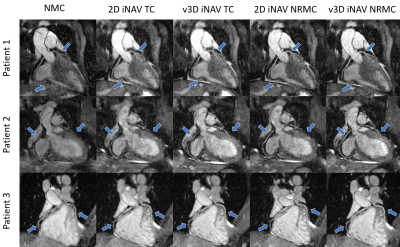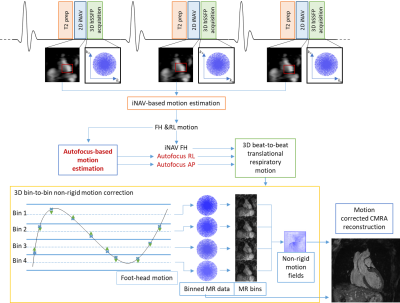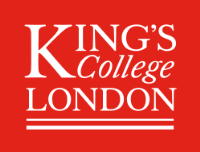Alina Psenicny1, Gastao Cruz1, Camila Munoz1, Reza Hajhosseiny1, Thomas Kuestner1, Karl P Kunze2, Radhouene Neji1,2, René M Botnar1, and Claudia Prieto1
1School of Biomedical Engineering and Imaging Sciences, King's College London, London, United Kingdom, 2MR Research Collaborations, Siemens Healthcare Limited, Frimley, United Kingdom
1School of Biomedical Engineering and Imaging Sciences, King's College London, London, United Kingdom, 2MR Research Collaborations, Siemens Healthcare Limited, Frimley, United Kingdom
A novel autofocused-based virtual
3D iNAV approach to enable improved 3D beat-to-beat and intra-bin non-rigid respiratory
motion corrected reconstruction for free-breathing 3D cardiac MRI is proposed.

Reformatted
images of 3 representative patients using the following reconstruction
frameworks: a) no motion correction (NMC), b) 2D iNAV translational correction
(2D iNAV TC), c) v3D iNAV translational correction (v3D iNAV TC), d) 2D iNAV
non-rigid motion compensation (2D iNAV NRMC) and e) the proposed v3D iNAV
non-rigid motion compensation (v3D iNAV NRMC). Improvements when using v3D iNAV
can be observed in all the cases, although in some cases (patient 1) these are
minor.

In the first step of proposed autofocus-based
virtual 3D iNAV non-rigid motion correction reconstruction framework, the FH
and RL motion is estimated from the 2D iNAVs. RL and AP motion is estimated
with autofocus approach, assuming linear relationship between the FH iNAV
signal and AP movement of the heart. Respiratory binning using
the FH motion estimated from the iNAVs is performed and beat-to-beat 3D
translational respiratory motion is applied to each bin. 3D non-rigid motion is
then estimated from respiratory-resolved bin images and used to produce motion-corrected datasets.
